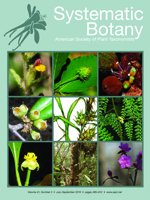Two species-rich lineages of Carex, C. sect. Phacocystis and the Vesicariae alliance, show a replicated and parallel radiation in the Northern hemisphere. Each group possesses a clade consisting of mostly boreal to arctic species and a second clade comprising more southerly distributed species. In this study, we ask if molecular differentiation is paralleled in both radiations by the diversification of quantitative morphological characters. We use nucleotide diversity to assess the molecular differentiation and methods derived from symbolic data analysis (SDA) for addressing the morphological diversification. The SDA turned out to be valuable for biological meta-analysis, because it is able to deal with the whole information content of interval and range data, respectively. We observed for some characters a weak correlation between molecular and morphological differentiation that, however, disappeared after Bonferroni correction. Therefore, in these phylogenetically young and radiating groups, diversification of molecular markers and quantitative morphological characters seem to be decoupled or hidden by homoplasy and plasticity.
How to translate text using browser tools
26 August 2016
Quantitative Morphological and Molecular Divergence in Replicated and Parallel Radiations in Carex (Cyperaceae) Using Symbolic Data Analysis
Matthias H. Hoffmann,
Sebastian Gebauer
ACCESS THE FULL ARTICLE

Systematic Botany
Vol. 41 • No. 3
Jul-Sep 2016
Vol. 41 • No. 3
Jul-Sep 2016
ETS
ITS
Mantel test
psbA-trnH
rps16
trnK-matK




